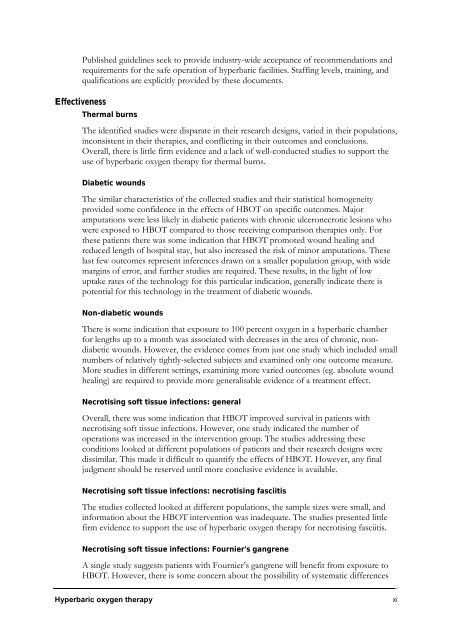Hyperbaric Oxygen Therapy - Hyperbaric Chamber Information ...
Hyperbaric Oxygen Therapy - Hyperbaric Chamber Information ...
Hyperbaric Oxygen Therapy - Hyperbaric Chamber Information ...
You also want an ePaper? Increase the reach of your titles
YUMPU automatically turns print PDFs into web optimized ePapers that Google loves.
Effectiveness<br />
Published guidelines seek to provide industry-wide acceptance of recommendations and<br />
requirements for the safe operation of hyperbaric facilities. Staffing levels, training, and<br />
qualifications are explicitly provided by these documents.<br />
Thermal burns<br />
The identified studies were disparate in their research designs, varied in their populations,<br />
inconsistent in their therapies, and conflicting in their outcomes and conclusions.<br />
Overall, there is little firm evidence and a lack of well-conducted studies to support the<br />
use of hyperbaric oxygen therapy for thermal burns.<br />
Diabetic wounds<br />
The similar characteristics of the collected studies and their statistical homogeneity<br />
provided some confidence in the effects of HBOT on specific outcomes. Major<br />
amputations were less likely in diabetic patients with chronic ulceronecrotic lesions who<br />
were exposed to HBOT compared to those receiving comparison therapies only. For<br />
these patients there was some indication that HBOT promoted wound healing and<br />
reduced length of hospital stay, but also increased the risk of minor amputations. These<br />
last few outcomes represent inferences drawn on a smaller population group, with wide<br />
margins of error, and further studies are required. These results, in the light of low<br />
uptake rates of the technology for this particular indication, generally indicate there is<br />
potential for this technology in the treatment of diabetic wounds.<br />
Non-diabetic wounds<br />
There is some indication that exposure to 100 percent oxygen in a hyperbaric chamber<br />
for lengths up to a month was associated with decreases in the area of chronic, nondiabetic<br />
wounds. However, the evidence comes from just one study which included small<br />
numbers of relatively tightly-selected subjects and examined only one outcome measure.<br />
More studies in different settings, examining more varied outcomes (eg. absolute wound<br />
healing) are required to provide more generalisable evidence of a treatment effect.<br />
Necrotising soft tissue infections: general<br />
Overall, there was some indication that HBOT improved survival in patients with<br />
necrotising soft tissue infections. However, one study indicated the number of<br />
operations was increased in the intervention group. The studies addressing these<br />
conditions looked at different populations of patients and their research designs were<br />
dissimilar. This made it difficult to quantify the effects of HBOT. However, any final<br />
judgment should be reserved until more conclusive evidence is available.<br />
Necrotising soft tissue infections: necrotising fasciitis<br />
The studies collected looked at different populations, the sample sizes were small, and<br />
information about the HBOT intervention was inadequate. The studies presented little<br />
firm evidence to support the use of hyperbaric oxygen therapy for necrotising fasciitis.<br />
Necrotising soft tissue infections: Fournier’s gangrene<br />
A single study suggests patients with Fournier’s gangrene will benefit from exposure to<br />
HBOT. However, there is some concern about the possibility of systematic differences<br />
<strong>Hyperbaric</strong> oxygen therapy xi



